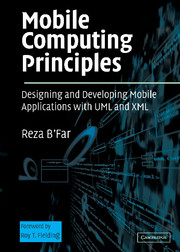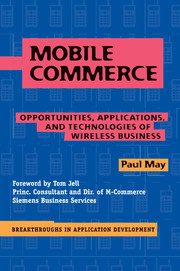Mobile Computing Principles
Written to address technical concerns that mobile developers face regardless of the platform (J2ME, WAP, Windows CE, etc.), this 2005 book explores the differences between mobile and stationary applications and the architectural and software development concepts needed to build a mobile application. Using UML as a tool, Reza B'far guides the developer through the development process, showing how to document the design and implementation of the application. He focuses on general concepts, while using platforms as examples or as possible tools. After introducing UML, XML and derivative tools necessary for developing mobile software applications, B'far shows how to build user interfaces for mobile applications. He covers location sensitivity, wireless connectivity, mobile agents, data synchronization, security, and push-based technologies, and finally homes in on the practical issues of mobile application development including the development cycle for mobile applications, testing mobile applications, architectural concerns, and a case study.
- Comprehensive
- Cutting edge
- Gives general concepts but still practical
Product details
March 2005Hardback
9780521817332
878 pages
254 × 178 × 46 mm
1.72kg
150 b/w illus.
Available
Table of Contents
- Part I. Introductions to the Main Topics:1. Introduction to mobile computing
- 2. Introduction to mobile development frameworks and tools
- 3. XML: the document and meta-data format for mobile computing
- 4. Introduction to UML
- Part II. Device Independent and Multi-Channel User Interface Development Using UML:
- 5. Generic user interface development
- 6. Developing mobile GUIs
- 7. Voice user Interfaces and mobile applications
- 8. Multi-channel and multi-modal user interfaces
- Part III. Additional Dimensions of Mobile Application Development:
- 9. Mobile agents and peer-to-peer architectures for mobile computing
- 10. Wireless connectivity and mobile applications
- 11. Synchronization and replication of mobile data
- 12. Mobility and location information
- 13. Active transactions
- 14. Mobile security
- Part IV. Putting the Project Together:
- 15. The mobile development process
- 16. Architecture, design, and technology selection
- 17. Mobile application implementation hurdles
- 18. Testing
- 19. A case study.




